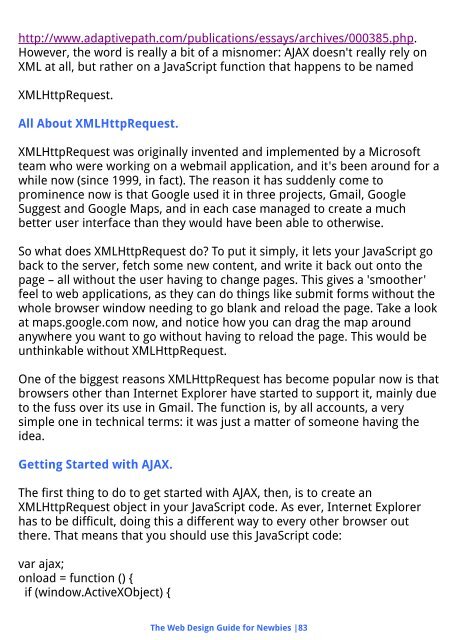You also want an ePaper? Increase the reach of your titles
YUMPU automatically turns print PDFs into web optimized ePapers that Google loves.
http://www.adaptivepath.com/publications/essays/archives/000385.php.<br />
However, the word is really a bit of a misnomer: AJAX doesn't really rely on<br />
XML at all, but rather on a JavaScript function that happens to be named<br />
XMLHttpRequest.<br />
All About XMLHttpRequest.<br />
XMLHttpRequest was originally invented and implemented by a Microsoft<br />
team who were working on a webmail application, and it's been around for a<br />
while now (since 1999, in fact). The reason it has suddenly come to<br />
prominence now is that Google used it in three projects, Gmail, Google<br />
Suggest and Google Maps, and in each case managed to create a much<br />
better user interface than they would have been able to otherwise.<br />
So what does XMLHttpRequest do? To put it simply, it lets your JavaScript go<br />
back to the server, fetch some new content, and write it back out onto the<br />
page – all without the user having to change pages. This gives a 'smoother'<br />
feel to web applications, as they can do things like submit forms without the<br />
whole browser window needing to go blank and reload the page. Take a look<br />
at maps.google.com now, and notice how you can drag the map around<br />
anywhere you want to go without having to reload the page. This would be<br />
unthinkable without XMLHttpRequest.<br />
One of the biggest reasons XMLHttpRequest has become popular now is that<br />
browsers other than Internet Explorer have started to support it, mainly due<br />
to the fuss over its use in Gmail. The function is, by all accounts, a very<br />
simple one in technical terms: it was just a matter of someone having the<br />
idea.<br />
Getting Started with AJAX.<br />
The first thing to do to get started with AJAX, then, is to create an<br />
XMLHttpRequest object in your JavaScript code. As ever, Internet Explorer<br />
has to be difficult, doing this a different way to every other browser out<br />
there. That means that you should use this JavaScript code:<br />
var ajax;<br />
onload = function () {<br />
if (window.ActiveXObject) {<br />
The Web Design Guide for Newbies |83


